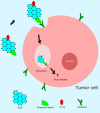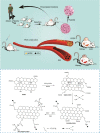Synthesis of graphene quantum dots and their applications in drug delivery
- PMID: 33008457
- PMCID: PMC7532648
- DOI: 10.1186/s12951-020-00698-z
Synthesis of graphene quantum dots and their applications in drug delivery
Abstract
This review focuses on the recent advances in the synthesis of graphene quantum dots (GQDs) and their applications in drug delivery. To give a brief understanding about the preparation of GQDs, recent advances in methods of GQDs synthesis are first presented. Afterwards, various drug delivery-release modes of GQDs-based drug delivery systems such as EPR-pH delivery-release mode, ligand-pH delivery-release mode, EPR-Photothermal delivery-Release mode, and Core/Shell-photothermal/magnetic thermal delivery-release mode are reviewed. Finally, the current challenges and the prospective application of GQDs in drug delivery are discussed.
Keywords: Bottom-up; Delivery-release mode; Drug delivery; Graphene quantum dots; Top-down.
Conflict of interest statement
The authors declare that they have no competing interests.
Figures




























References
-
- Bak S, Kim D, Lee H. Graphene quantum dots and their possible energy applications: a review. Curr Appl Phys. 2016;16:1192–1201. doi: 10.1016/j.cap.2016.03.026. - DOI
Publication types
MeSH terms
Substances
Grants and funding
LinkOut - more resources
Full Text Sources
Other Literature Sources

